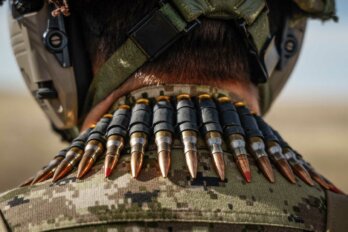On June 21, a crowd gathered at the Millbrook Cultural and Heritage Centre in Millbrook, Nova Scotia, cheered and applauded as a red cloth draped over a display case fell away, revealing a set of Mi’kmaw regalia from 1842. The regalia, trimmed with colourful silk ribbons and ornamented with glass beads, had recently returned to Mi’kma’ki after more than 130 years in the collection of Museums Victoria in Australia.
Heather Stevens, the centre manager, spent a decade lobbying the museum for the return of the ceremonial regalia—which included a man’s jacket, shoes, brooch, pipe, and pouch—on behalf of her Mi’kmaq people. She was supported by former member of Parliament Bill Casey, who, moved by Stevens’s efforts, had drafted the Aboriginal Cultural Property Repatriation Act to call on the federal government to develop a national strategy for the return of significant cultural items as well as Indigenous remains, many of which were stolen, confiscated by Indian agents, or sold under duress.
The Canadian writer and artist Samuel Huyghue, who obtained the Mi’kmaw regalia while living in Atlantic Canada and donated it to the Australian museum upon retirement, had subscribed to the prevailing view that Indigenous people were being eradicated, and he likely saw the collection of cultural items as a benevolent act of preservation. (He was fascinated by Mi’kmaq culture and even published a serialized novel, between 1841 and 1843, entitled Argimou: A Legend of the Micmac.) But at scale, the collection of millions of Indigenous items was just another expression of forcible assimilation practices imposed to extinguish Indigenous cultures, preserving them only as curiosities behind glass.
Casey, explaining the bill in Parliament in 2018, said of the Mi’kmaw regalia: “It is more than just an artifact. It is their history, it is their people, it is the spirit of their people. I do not pretend to be able to capture the entire meaning that artifacts have to First Nations peoples, but I know it is so important for them to have them back.” The bill passed unanimously in the House of Commons but stalled after reaching the Senate. Since then, the question of what to do with an estimated 6.7 million Indigenous belongings held by Canadian institutions—along with countless others in private and public collections overseas—has gone unanswered.
The inertia is emblematic of national commitments to reconciliation: a lot of talk, little action. In 2022, the Canadian Museums Association and the Association of Canadian Archivists both published national reviews of their policies, in response to specific calls to action in the Truth and Reconciliation Commission’s final report. These reviews are not frivolous, but eight years after the TRC report, they are just more promises that have yet to be fulfilled.
What’s at stake isn’t just objects: Canadian museums and heritage sites hold the remains of an estimated 2,500 Indigenous ancestors, not including the estimated hundreds more held in university collections and many more confined to international collections. The process of bringing them home, even from cooperative institutions, can be costly: the Haida Nation, which has successfully repatriated the remains of over 500 ancestors from museum collections, spent more than $1 million on its efforts, according to the Globe and Mail.
By comparison, the United States, since 1990, has required federally funded institutions to repatriate the remains of Indigenous ancestors under the Native American Graves Protection and Repatriation Act. NAGPRA is not without flaws: only half of the ancestral remains held in institutions have been repatriated since the act was passed more than three decades ago, according to ProPublica. Critics point to a painfully slow process that’s cumbersome for tribes and rife with legislative loopholes that allow institutions to dodge accountability. One such method is by declaring the remains to be “culturally unidentifiable” as a result of poor documentation on the part of institutions and collectors. The legislation also only extends to tribes in the US; ancestors belonging to Indigenous peoples in Canada are exempt from the act. Negotiating repatriation across borders can add layers of bureaucratic complexity and obstruction. In Europe, National Museums Scotland refused a request to repatriate the remains of two Beothuk ancestors on the grounds that they would return the remains only to direct descendants, before finally relenting in 2020 and releasing them—into the possession of another institution, the Rooms museum in St. John’s, Newfoundland and Labrador. It is often the case that the onus is placed on Indigenous communities to prove their connection to the items and ancestors appropriated and exhibited by settler institutions.
Robin R. R. Gray, a Ts’mysen and Mikisew Cree scholar, has proposed a different paradigm for the return of Indigenous belongings, one she calls rematriation. In 2022, she was appointed the first Special Advisor on Indigenous Rematriation at the University of Toronto Mississauga. Gray attributes the term to the late Salish/Cree writer and activist Lee Maracle, who, in her speech “Indigenous Women and Power,” said that restoring Indigenous women to their traditional positions of power and influence was a necessary part of decolonization. Both Gray and Maracle argue that it’s not enough to merely return, using settler processes and notions of ownership, what was taken; instead, the process must seek to repair and restore, through Indigenous laws and protocols, what has been fractured by colonialism. After all, Gray points out, the colonial frameworks that were employed to dispossess Indigenous people in the first place are ill-suited to repair the damage. Rematriation, on the other hand, requires understanding cultural items as being entwined with living nations—a process of “revitalizing the relationship between Indigenous lands, heritage, and bodies based on Indigenous values and ways of knowing, being, and doing,” Gray wrote in Rematriation: Ts’msyen Law, Rights of Relationality, and Protocols of Return.
This is a radical departure from how Indigenous items have been treated in settler institutions, where they have been deliberately divorced from their social and political contexts, transformed from living cultural expressions into property. The process by which millions of Indigenous items and ancestors were removed from their nations was extractive, premised upon and justified by an assumption: extinction.
Rematriation, then, is more than the return of property; it’s a process of reanimation. Gray, who visited the archives of Columbia University in 2012 to hear Ts’mysen songs that had been recorded and then sold to the institution by a settler researcher, found her peoples’ history languishing in an archive, marred by incomplete and inaccurate documentation. To reclaim the recordings, Gray engaged Ts’mysen community members to listen to them and determine who the songs and stories belonged to, according to their nation’s protocols. “Our songs remained static, confined to archives for so long, but they became activated through our collective research,” she wrote.
A common refrain among settlers is that, without museums, these items would be “lost” anyway as Indigenous nations lacked things like climate-controlled facilities to preserve them. But many cultural belongings, like the Ts’mysen recordings, are effectively lost because collectors and institutions lack the cultural knowledge to make sense of them—or even recognize the depths of their own ignorance. In 2022, the Royal BC Museum in Victoria apologized after mistakenly declaring a stone carving to be an ancient Indigenous monument when it had in fact been made in 2017 by an amateur artist on a beach.
It’s long past time for concrete action that enables Indigenous communities across Canada to lead those efforts. (Currently, BC is the only province that has committed some funding for First Nations–led repatriation projects.) But the processes by which Indigenous peoples are reunited with their heritage are also crucial, each one a profound act of reclamation, restoration, and healing.
At the unveiling of the reclaimed Mi’kmaw regalia, Heather Stevens recalled the emotional significance of that long-awaited reunion. “When I first saw the crate, I went over and laid on it . . . had my hands on it, and I bawled,” she said at a press conference. “I cried. Because to me, it was [that] we found it, and it was coming home.”





